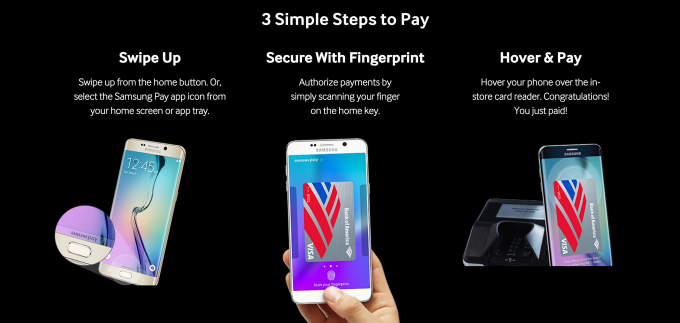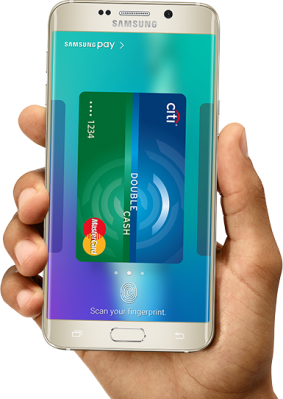Samsung Pay, the device maker’s competitor to rival NFC-based payment services including Apple Pay and Android Pay, is now live in the U.S. following its earlier launch in South Korea, where it saw over $30 million in transaction volume during its first month. The payments platform, based on technology acquired from LoopPay, gives Samsung what it hopes will be a competitive advantage in the payments market, as it’s not limited to NFC-based payments alone.
Instead, Samsung Pay offers a way for consumers to pay using their Samsung smartphones via either NFC technology, like Apple and Google’s solution, or by emulating a magnetic stripe card. The latter item was the basis for Samsung’s $250 million acquisition of the startup LoopPay, which had developed and patented a technology called Magnetic Secure Transmission.
Though the U.S. is shifting to EMV-based credit and debit cards, which are more secure that the traditional magnetic stripe cards, there will still be a transitional period where not all customers’ cards have been upgraded to the chip-and-PIN technology, and not all point-of-sale terminals will support EMV transactions. In other words, magstripe transactions will stick around for some time.
That, Samsung hopes, will give its mobile payments service the edge in the near-term. And as payment terminals move to support EMV and NFC technology instead, Samsung Pay will continue to work with them, too.
While Apple iPhone users and NFC-based Android smartphone users today have to check to see if their terminal supports NFC transactions before they can tap their phone to pay, with Samsung Pay-enabled smartphones, tap-and-pay works at nearly any point-of-sale terminal where you can swipe your card to pay thanks to its support for magstripe card emulation.
However, Samsung’s solution is not without its challenges. For starters, the payment technology is only enabled on select devices – the Galaxy S6, S6 edge, S6 edge+ and Note5 devices. (It will also support NFC on Samsung Gear S2 devices in select countries in the future.) Competitor Android Pay, meanwhile, works on nearly any NFC-enabled Android phone running Android 4.4 (KitKat) or higher.
In addition, Samsung hasn’t forged a deal with Verizon, one of the U.S.’s top carriers, which means Samsung Pay for now only works on AT&T, Sprint, T-Mobile and U.S. Cellular’s networks.
Meanwhile, Samsung Pay is launching in partnership with a number of financial partners, including American Express, Visa and MasterCard, as well as Bank of America, Citi and U.S. Bank. But, out of the gate, Android Pay works with those partners as well as Discover and a number of other banks and issuers, including Capital One, Navy Federal Credit Union, PNC, Regions, USAA and Wells Fargo. And rival Apple Pay’s list of supporting banks is even more extensive than either of these newer Android solutions.
In other words, Samsung Pay will be more limited in terms of the number of U.S. customers it can reach at launch. And then, those supported customers who know about the service and understand how it works will be even fewer, as consumer adoption of mobile payments is still heating up.

For those with Samsung Pay-enabled phones, using the system is fairly simple. To make a payment, users swipe up, scan their fingerprint and then pay – similar to how Android Pay works. Consumers who are eligible to use Samsung Pay will first need to download an over-the-air software update to their phone. Of course, availability of software updates will vary by service provider.
Samsung also promised that Samsung Pay will arrive in China, Spain and the U.K. in the future, but hasn’t provided a time frame.
